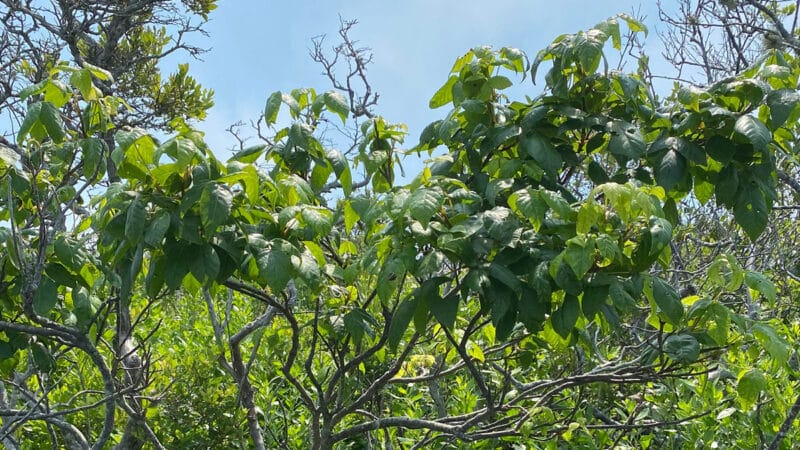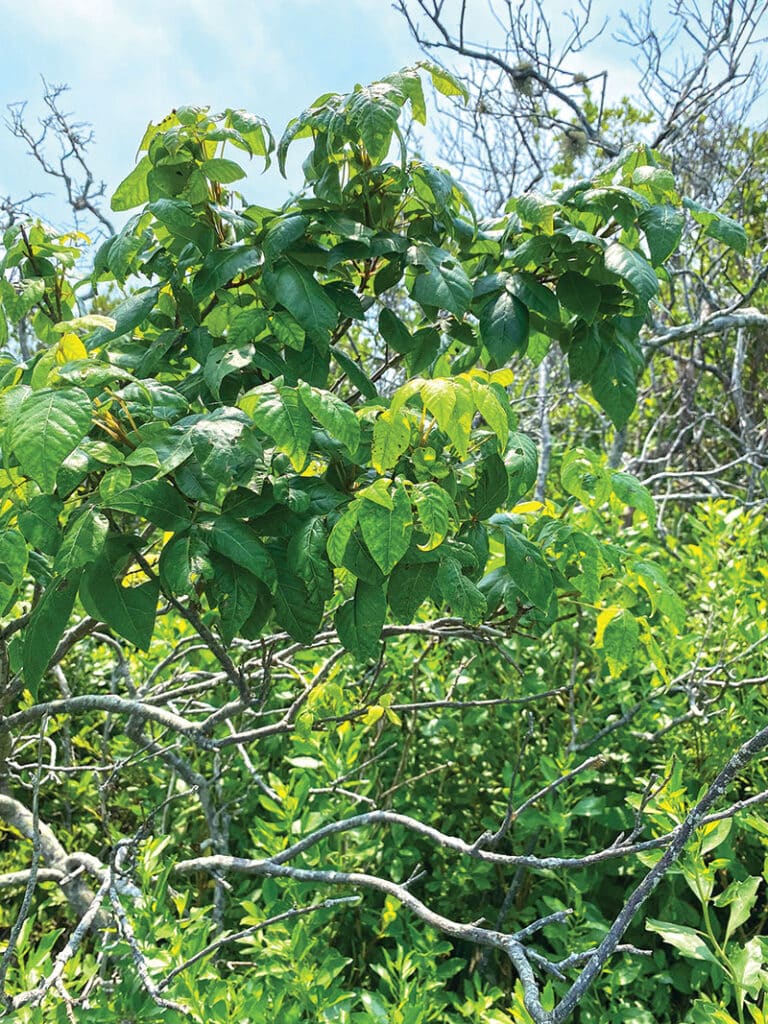by Dr. Sarah Treanor Bois, PhD
Director of Research & Education at the Linda Loring Nature Foundation
There is a children’s book of poetry called Love Poems for the Unloved by Diane Lang which highlights species in nature that are often given a bad rap. Some of the poems focus on spiders or snakes, others bats and vultures. In the spirit of appreciating something in nature that is often much maligned and which, quite honestly, I personally suffer from, let’s focus today on poison ivy.
Poison ivy (Toxicodendron radicans) is a woody plant native to Nantucket. Sometimes it looks like a forb, sometimes a vine it can take many forms. It is a in the same family of plants (Anacardiaceae) as mango and cashew. People who are extremely allergic to poison ivy may also be sensitive to those foods. As the name implies, it is “toxic” or “poisonous” to the touch for many individuals. While 85 % of Americans are allergic to poison ivy, they’re actually allergic to urushiol, the rash-causing oil produced by the plant.
Poison ivy is a plant I love to hate or hate to love. I am extremely allergic to the oil myself, but I marvel at its ability to morph into many plant forms. As a woody vine it climbs and girdles trees as can be seen along the edge of the Nantucket State Forest. It can appear herbaceous, growing among the low bush blueberries and wildflowers of summer (take care when you harvest). Each stem seems to know how tall to grow to mimic the surrounding plants. It can be shrubby in nature, growing in and among the bayberries and huckleberries growing no more than hip height. Despite being a master of disguise, there are some tell-tale identification clues so that you can avoid contact.
The first step in avoiding a rash is to know how to identify poison ivy. I always make sure to highlight the plant on nature explorations especially with kids. “Leaves of three, let it be,” is an old rhyme that works most of the time. While many native, innocuous plants also have clusters of three leaves, it may be best to avoid all “leaves of three” if you’re not sure. Unlike some plants in the blackberry family with three leaves, poison ivy does not have thorns and generally has smooth leaf edges, though sometimes it is “variable toothed.” That basically means it does what it wants when it wants—ugh! Its leaves are generally shiny, though not always: especially when along one of Nantucket’s many dirt roads.
Despite my severe allergy, there is much to admire about poison ivy. First of all, the berries produced by the plant are a great food source for birds: both migratory and resident populations. The urushiol oil only affects humans, so birds, deer, and other wildlife aren’t affected the way we are. Right now, during July, the berries are fully visible. They are small and white, about the size of a bayberry.
Another thing to like about poison ivy? It may soon rise as our overlord. Just kidding, but it does have amazing abilities to thrive with climate change. Warming temperatures and elevated carbon dioxide levels are shown to be beneficial for poison ivy, making it grow faster, bigger, and more potent. Researchers from Duke University conducted a six-year study looking at the effects of elevated carbon dioxide levels on forest plots. They exposed the plots to CO2 levels expected at the end of the 21st century (570ppm). As a result of high greenhouse gas levels, poison ivy increased its biomass by 67 percent more than poison ivy that did not have elevated carbon dioxide levels. It increased in photosynthesis, water use efficiency, growth, and population biomass. In addition to growing faster, poison ivy in the study also produced more urushiol oil. Oh joy! In the future, there will be more poison ivy, the plants will be bigger plants, and the urushiol oil will be more. At least the birds will be happy.
Just when you thought it couldn’t get any better, recent work on updating the Nantucket Flora led by Kelly Omand of the Nantucket Conservation Foundation, has found that we actually have a second species of poison ivy on island (lucky us!). Toxicodendron rydbergii, also known as western poison-ivy, is distinguished from the “eastern” version as being more prevalent in wet areas including salt marshes. It also grows as a small shrub and does not exhibit a viny form. The western version does not have the hairy looking aerial roots you can see on vines of the other species. Where I have seen it, it almost looks like a small tree rather than its shorter cousin.
Despite its name, western poison-ivy is native to Nantucket. It may be a new species in the flora, but that has more to do with proper identification and taxonomy than anything else. If you think you see it, add the observation to iNaturalist and help us document more occurrences of the species.
I didn’t want to leave us all just hating on this important native species. All kidding aside, it’s not just birds and deer that benefit from this plant. I don’t usually subscribe to the edict that a plant must have human value to be important. But sometimes with a plant like poison ivy, I have to remind myself of the benefits.
Poison ivy can have immeasurable value to shoreline areas due to its salt tolerance and ability to grow in impoverished soils. It can be used as a conservation tool to keep people out of many areas and is an effective barrier and thicket in many coastal locales. Poison ivy plays an important role in protecting the local sand dunes, which are inhospitable to many plants. Few plants can tolerate the desert-like conditions. Along with beach grass, bayberry, and other dune-loving species, poison ivy’s sand stabilizing properties make it essential to protecting our dunes—an important aspect of coastal resiliency.
Lastly, come fall, poison ivy leaves turn a brilliant crimson color. Driving down the Milestone Road, it brings some bright colors to the evergreen pines of our state forest. At least we have that to look forward to.




